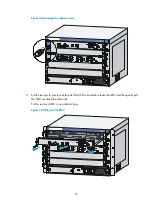
68
Verifying and diagnosing transceiver modules
Commonly used transceiver modules
Transceiver type
Application scenarios
Whether can be an
optical transceiver
module
Whether can be an
electrical
transceiver module
SFP (Small Form-factor
Pluggable)
Generally used for
100M/1000M Ethernet
interfaces
Yes No
XFP (10-Gigabit small
Form-factor Pluggable)
Generally used for 10G Ethernet
interfaces
Yes No
Verifying transceiver modules
To verify transceiver modules, you can use the
display transceiver interface
command to display the key
parameters of the transceiver modules, including transceiver module type, connector type, central
wavelength of the laser sent, transfer distance, and vendor name.
To display the transceiver module information:
Task Command
Remarks
Display key parameters of the transceiver
module in a specified interface.
display transceiver interface
[
interface-type interface-number
]
Available for all transceiver
modules
Diagnosing transceiver modules
The firewall provides the alarm function for transceiver modules for easy diagnosis.
To display the alarm information about transceiver modules:
Task Command
Remarks
Display the current alarm
information of the transceiver
module in a specified interface.
display transceiver alarm interface
[
interface-type interface-number
]
Available for all transceiver
modules
Troubleshooting system exceptions
Configuring the exception handling methods
You can use one of the following methods to handle system exceptions:
•
reboot
—The firewall reboots the failed MPU to recover from the error condition.
•
maintain
—The MPU stays in the error condition so you can collect complete data, including error
messages, for diagnosis. In this approach, you must manually reboot the firewall
















































